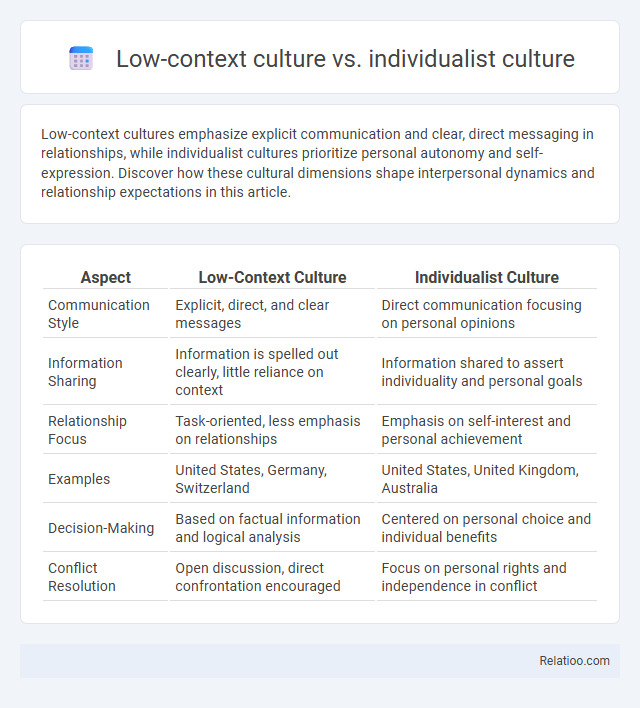Low-context cultures emphasize explicit communication and clear, direct messaging in relationships, while individualist cultures prioritize personal autonomy and self-expression. Discover how these cultural dimensions shape interpersonal dynamics and relationship expectations in this article.
Table of Comparison
| Aspect | Low-Context Culture | Individualist Culture |
|---|---|---|
| Communication Style | Explicit, direct, and clear messages | Direct communication focusing on personal opinions |
| Information Sharing | Information is spelled out clearly, little reliance on context | Information shared to assert individuality and personal goals |
| Relationship Focus | Task-oriented, less emphasis on relationships | Emphasis on self-interest and personal achievement |
| Examples | United States, Germany, Switzerland | United States, United Kingdom, Australia |
| Decision-Making | Based on factual information and logical analysis | Centered on personal choice and individual benefits |
| Conflict Resolution | Open discussion, direct confrontation encouraged | Focus on personal rights and independence in conflict |
Introduction to Low-Context and Individualist Cultures
Low-context cultures rely heavily on explicit communication where messages are clear and detailed, minimizing ambiguity. Individualist cultures emphasize personal goals and self-expression, prioritizing individual rights and independence over group conformity. Understanding your communication style in these cultural contexts enhances effective interaction and reduces misunderstandings.
Defining Low-Context Culture
Low-context culture emphasizes explicit communication where messages are conveyed primarily through clear verbal expression rather than situational cues or nonverbal signals. This contrasts with individualist culture, which prioritizes personal autonomy and self-expression, often aligning with low-context communication but focusing more on individual goals than social harmony. Understanding low-context culture involves recognizing its reliance on direct, detailed information exchange to minimize ambiguity in interactions.
Understanding Individualist Culture
Individualist culture emphasizes personal autonomy, self-reliance, and individual achievements, valuing personal goals over group interests. Low-context culture, often overlapping with individualist societies, relies heavily on explicit communication, clear, direct language, and detailed information to ensure mutual understanding. Understanding your interactions in an individualist culture means recognizing the importance of clear communication and respecting personal independence in both social and professional settings.
Key Differences Between Low-Context and Individualist Cultures
Low-context cultures rely heavily on explicit verbal communication where meanings are clearly spelled out, while individualist cultures prioritize personal goals and self-expression over group cohesion. Low-context cultures emphasize directness and clarity in communication, contrasting with individualist cultures that value independence and personal achievement. Understanding these differences is crucial for effective intercultural communication, as low-context communication style focuses on message content, whereas individualist culture shapes communication around personal identity and autonomy.
Communication Styles in Low-Context vs Individualist Societies
Low-context cultures rely heavily on explicit verbal communication, where messages are clear, direct, and unambiguous, minimizing reliance on situational cues. In individualist societies, communication prioritizes personal expression and self-assertion, emphasizing clarity, independence, and straightforwardness to convey individual opinions and needs. Both low-context and individualist cultures value transparency and verbal clarity, but individualist communication often includes more personal accountability and direct feedback compared to the broader low-context cultural emphasis on explicit messaging.
Social Relationships and Group Dynamics
Low-context cultures rely on explicit communication where messages are clear and direct, shaping social relationships to emphasize individual interactions rather than group harmony. Individualist cultures prioritize personal goals and autonomy, often leading to social relationships based on individual achievements and self-expression within the group dynamics. Understanding these cultural distinctions helps you navigate social relationships by recognizing when group cohesion or individual contributions are culturally valued.
Workplace Behaviors and Decision-Making
Low-context cultures emphasize explicit communication and detailed information exchange in workplace behaviors, ensuring clarity and reducing misunderstandings during teamwork and collaboration. Individualist cultures prioritize personal goals and autonomy, influencing decision-making processes by encouraging independent judgment and accountability. Your ability to navigate these cultural traits can enhance effective communication and improve decision outcomes in a diverse professional environment.
Conflict Resolution Approaches
Low-context cultures prioritize explicit communication and rely on clear verbal expressions to resolve conflicts, ensuring all parties understand the issues directly without hidden meanings. Individualist cultures emphasize personal responsibility and assertiveness in conflict resolution, often encouraging open dialogue to address personal needs and goals. Low-context cultures contrast with high-context cultures by minimizing reliance on shared background knowledge, favoring structured and transparent methods to resolve disputes efficiently.
Cross-Cultural Challenges and Misunderstandings
Low-context cultures prioritize explicit communication, relying heavily on clear, direct messages to convey meaning, which contrasts with individualist cultures that emphasize personal goals and self-expression, potentially causing misunderstandings when group harmony or implicit cues are overlooked. Cross-cultural challenges arise when individuals from low-context backgrounds interpret indirect communication styles of high-context cultures as evasive or unclear, while individualist perspectives may clash with collectivist values, leading to misinterpretations of intent or commitment. Your ability to recognize these differences in communication styles and cultural priorities is crucial to navigating and resolving common misunderstandings in international or multicultural interactions.
Practical Tips for Navigating Low-Context and Individualist Cultures
Navigating low-context and individualist cultures requires clear, direct communication and respect for personal autonomy, emphasizing explicit information to avoid misunderstandings. Practical tips include prioritizing straightforward language, setting clear expectations, and encouraging open dialogue to foster transparency and personal accountability. Understanding cultural norms around independence and precise expression enhances collaboration and reduces cultural friction in professional and social settings.

Infographic: Low-context culture vs Individualist culture
 relatioo.com
relatioo.com